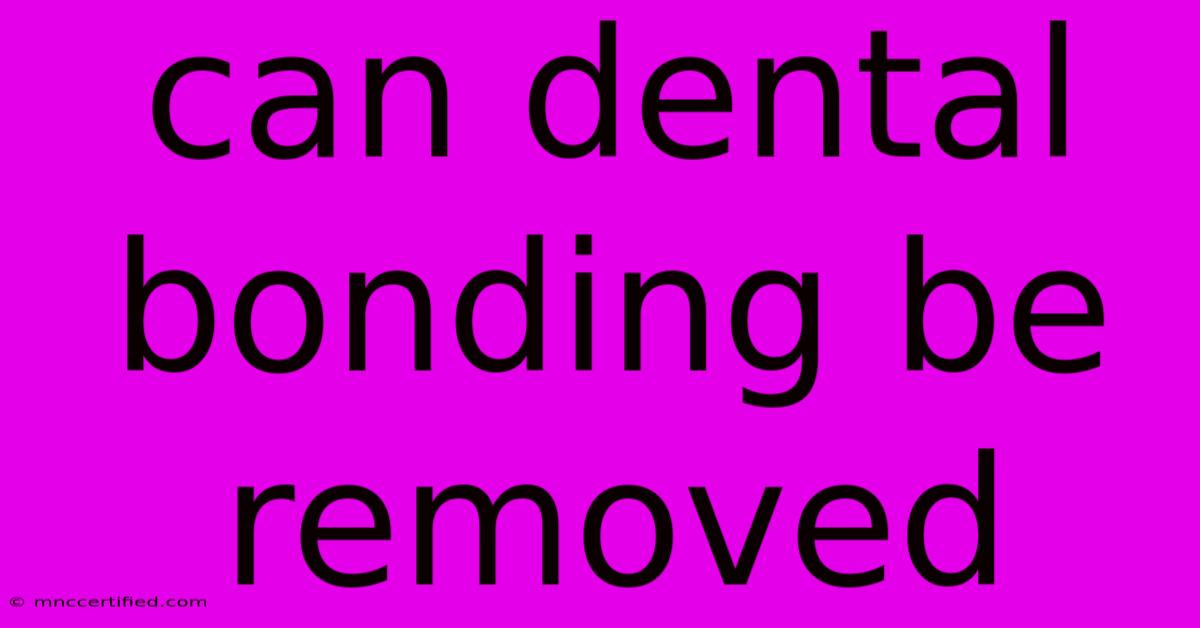Can Dental Bonding Be Removed

Table of Contents
Can Dental Bonding Be Removed? A Comprehensive Guide
Dental bonding is a popular cosmetic procedure used to improve the appearance of teeth. It involves applying a tooth-colored resin to the surface of the teeth, shaping it, and then hardening it with a special light. But what happens if you're unhappy with the results, or if the bonding becomes damaged? The crucial question is: can dental bonding be removed? The short answer is yes, but it's a process that requires professional dental care.
Understanding the Dental Bonding Removal Process
Removing dental bonding isn't a simple DIY project. It requires the expertise of a dentist to avoid damaging the underlying tooth enamel. The process typically involves:
1. Preparation and Assessment
Before removal, your dentist will assess the bonding material, its placement, and the overall health of your teeth. This step is crucial to determine the best removal technique and minimize any potential risks. They'll likely take X-rays to ensure there are no underlying issues.
2. Careful Removal
The dentist will use specialized dental tools to carefully remove the bonding material. This process requires precision to avoid damaging the natural tooth enamel underneath. Different types of bonding may require different techniques, with some being more easily removed than others. The dentist might use a combination of instruments, such as small hand tools or even a laser, depending on the situation.
3. Polishing and Finishing
Once the bonding is removed, the dentist will polish and smooth the surface of your teeth to ensure a comfortable and aesthetically pleasing result. Any minor imperfections or irregularities will be addressed to restore the natural look of your teeth.
4. Post-Removal Care
After the removal procedure, your dentist will provide instructions for post-removal care. This usually involves maintaining good oral hygiene practices, including brushing and flossing regularly. You may experience some sensitivity in the treated area, which is usually temporary.
Reasons for Dental Bonding Removal
There are several reasons why someone might choose to have dental bonding removed:
- Aesthetic Dissatisfaction: The most common reason is dissatisfaction with the appearance of the bonding. The color might not match the surrounding teeth, or the shape and size might be undesirable.
- Chipping or Damage: Dental bonding, while durable, can chip or crack over time, especially with excessive biting force or trauma.
- Staining: Despite regular brushing and flossing, bonding can be susceptible to staining, particularly from certain foods and drinks like coffee and red wine.
- Decay Underneath: In rare cases, decay can develop underneath the bonding, necessitating its removal for treatment.
- Preparation for Other Procedures: Bonding might need removal before other dental procedures, such as crowns or veneers.
Potential Risks and Complications
While generally safe, dental bonding removal can carry some potential risks:
- Enamel Damage: Improper removal techniques can damage the underlying tooth enamel, leading to sensitivity or the need for further restorative work. This highlights the importance of seeking professional dental care for removal.
- Sensitivity: Temporary sensitivity to temperature changes or pressure is common after removal, but usually resolves quickly.
- Discoloration: In rare cases, slight discoloration of the underlying tooth may occur.
Choosing the Right Dentist
Finding a qualified and experienced dentist is crucial for a successful dental bonding removal. Look for a dentist with extensive experience in cosmetic dentistry and restorative procedures. Check reviews and testimonials to ensure they have a good reputation for delivering high-quality care.
Conclusion
Dental bonding is a reversible procedure. While the process of removal requires professional dental expertise, it's a relatively straightforward procedure with a high success rate. If you're considering having your dental bonding removed, consult with a dentist to discuss your options and ensure a safe and effective outcome. Don't attempt to remove the bonding yourself, as this can lead to significant damage to your teeth. Remember to prioritize your oral health and seek professional help for all dental concerns.

Thank you for visiting our website wich cover about Can Dental Bonding Be Removed. We hope the information provided has been useful to you. Feel free to contact us if you have any questions or need further assistance. See you next time and dont miss to bookmark.
Featured Posts
-
Israel Hezbollah Truce Cautious Optimism Lingering Fears
Nov 28, 2024
-
Trading Post In Salt Lake City
Nov 28, 2024
-
25 K Await Lana Del Rey Concert
Nov 28, 2024
-
England In Nz Bazball Tested
Nov 28, 2024
-
What Does Unsecured Bond Mean
Nov 28, 2024